Legumes: The Nitrogen Specialists
 |
| Nodules on white lupins. This crop was recently introduced to Canadian maritime provinces to provide silage and high protein grain for livestock. |
Rhizobia infect roots of legumes and induce formation of specialized nodules. Inside the nodules, these bacteria are transformed into enlarged, non-growing cells called bacteroids. They are bathed in leghaemoglobin, a molecule which like the hemoglobin of our blood reflects red light, and imparts pink to red coloration to the nodule interior. The leghaemoglobin functions in transport of oxygen to the bacteroids. Using energy supplied by the plant, the bacteroids fix N2, converting it first to ammonia, and then to organic N compounds which are released and taken up by the host plant.
 Apios americana has flowers typical of many legumes: bilaterally symmetrical flowers with 5 petals; flowers occurring in clusters. |
This process relieves legumes of dependence on "available" forms nitrogen - ammonium and nitrate - which are commonly in short supply. Thus legumes can exhibit good growth in strongly N limited situations where non-legumes exhibit very limited growth. In turn, the decomposition of legume biomass enriches the soil in available N, allowing increased growth of non-legumes.
There has been a general decline in legumes relative to non-legumes in agriculture over the last half century. This is largely because of the ready availability of nitrogen fertilizers to fertilize cereals. Cereals are generally higher yielding than legumes, and as a single food source provide a more balanced mixture of carbohydrate and protein for humans and livestock than do the more protein rich legumes.
Nitrogen fertilizer is produced by an energy intensive process of industrial nitrogen fixation. Partly as a result of increased energy costs, there has been some movement in recent years to grow more legumes, for example, substituting legume-grass forages for some of the grain based concentrate now fed to livestock. Traditional agriculture - still important in much of the developing world - and organic agriculture which is of increasing significance in the industrialized world are highly dependent on legumes to provide inputs of N. Approximately 30 to 60% of a farm system needs to be planted in legumes for self sufficiency in N and modest to high yields of the non-legumes, the exact number depending on the level of export from the farm and recycling within the farm. The legume crops are integrated into crop rotations, or in some farms are grown mainly as forage crops (often in mixtures with grasses) and transfers of N to cutivated crops take place via applications of livestock manure.
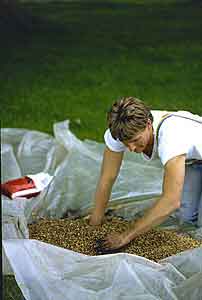 | Rhizobial inoculant being mixed with soybean seeds. Often, when a new legume is introduced to a region or field, strains or species of rhizobia that will infect that particular legume are absent or present in very low numbers. Commercial inoculants are commonly prepared by growing the bacteria in broth and mixing the broth with ground peat or other carrier which is stored dry. In photo, the peat based inoculant was wetted slightly to make it sticky and is being mixed with seed just before putting it in the seeder. |
 |  Photo at left is of recently formed nodules on white clover growing a testube. Nodules are about 1 mm wide. The red color is due to leghaemoglobin. Photo at right illustrates mature nodules on roots taken from white clover growing in a lawn. Photo at left is of recently formed nodules on white clover growing a testube. Nodules are about 1 mm wide. The red color is due to leghaemoglobin. Photo at right illustrates mature nodules on roots taken from white clover growing in a lawn. |
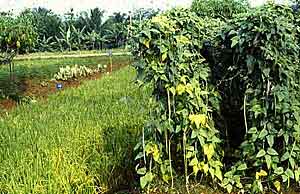 Traditional agriculture in the tropics has produced a huge variety of edible legume fruits and seeds. At right, "Yard Long Beans" are growing on raised beds next to paddy rice in a traditional Sorjun farming system in Indonesia. Traditional agriculture in the tropics has produced a huge variety of edible legume fruits and seeds. At right, "Yard Long Beans" are growing on raised beds next to paddy rice in a traditional Sorjun farming system in Indonesia. |
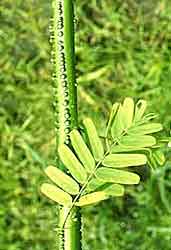  |
| The legume Sesbania rostrata grows in flooded soils and is nodulated on the stems rather than on the roots. Figure at right shows growth after 4 weeks; it will be turned into the soil to make green manure for paddy rice. |
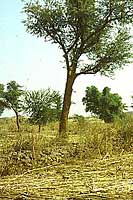 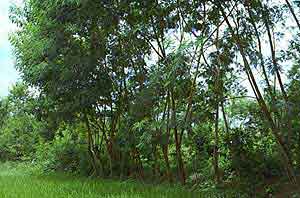 |
| Leguminous trees are very common in tropical regions and are important agroforestry species. At left, Albizzia alba maintains its green growth through the dry season in Burkina faso providing fodder for livestock; the residues in the foreground are of millet which is grown during the rainy season. Photo at right is of Leucaena leucocephala in the Philippines: these trees, less than 2 years old, will be cut to provide firewood. |
About a legume used traditionally by Micmac people for its tuber
An important grain legume.
about the complementarity of maize and beans in the field and in the diet
Intensive rotational grazing stimulates clover.
About vetch, variously a weed, cover crop and forage.
On use of red clover as a cover crop following maize
Intercropping leguminous trees and cultivated crops.
An explanation of why yields of why high protein crops (such as soyabeans) are lower than those of low protein crops.
Vignette prepared by David Patriquin
March 11, 2001. Photos by David Patriquin